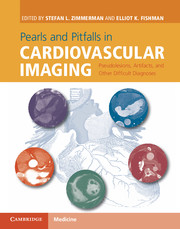 Pearls and Pitfalls in Cardiovascular Imaging
Pearls and Pitfalls in Cardiovascular Imaging from Section 5 - Pulmonary arteries
Published online by Cambridge University Press: 05 June 2015
Imaging description
Pulmonary artery (PA) sarcoma is a rare tumor that is difficult to diagnose due to clinical presentation and imaging appearance that mimic pulmonary embolism. On contrast-enhanced CT, pulmonary artery sarcoma can appear nearly identical to a pulmonary embolism, usually appearing as a smooth, lowattenuation intraluminal filling defect (Figure 46.1). Clinically, the absence of risk factors for thrombus formation, progressive worsening of symptoms, and persistence of the pulmonary artery filling defect despite anticoagulation therapy should raise suspicion for pulmonary artery sarcoma (Figure 46.2). CT features that may help distinguish sarcoma from embolus include involvement of the main and proximal pulmonary artery branches, filling and expansion of the entire luminal diameter, and extravascular extension of soft tissue into the adjacent lung parenchyma. Contrast enhancement, when identified, is usually heterogenous and will suggest the diagnosis (Figure 46.1). However, enhancement may be difficult to appreciate on CT examinations performed with pulmonary embolism protocol due to early phase of acquisition. Delayed venous phase images or enhanced chest MRI with dynamic post-contrast imaging can be used to confirmthe presence of enhancement. PA sarcomas will show increased metabolic activity on FDG-PET examinations, which can be helpful in difficult cases.
Importance
Incorrect interpretation of a PA sarcoma as a pulmonary embolism will lead to a delay in diagnosis and delayed institution of proper treatment.
Typical clinical scenario
Pulmonary artery sarcomas are rare tumors, with only 250 cases reported in the literature to date. Patients are typically middle aged and usually present with symptoms of dyspnea.
Differential diagnosis
The primary differential diagnosis is bland thromboembolism. Metastatic tumor emboli from a non-lung primary can also present with enhancing, expansile pulmonary artery filling defects and should also be considered.
To save this book to your Kindle, first ensure no-reply@cambridge.org is added to your Approved Personal Document E-mail List under your Personal Document Settings on the Manage Your Content and Devices page of your Amazon account. Then enter the ‘name’ part of your Kindle email address below. Find out more about saving to your Kindle.
Note you can select to save to either the @free.kindle.com or @kindle.com variations. ‘@free.kindle.com’ emails are free but can only be saved to your device when it is connected to wi-fi. ‘@kindle.com’ emails can be delivered even when you are not connected to wi-fi, but note that service fees apply.
Find out more about the Kindle Personal Document Service.
To save content items to your account, please confirm that you agree to abide by our usage policies. If this is the first time you use this feature, you will be asked to authorise Cambridge Core to connect with your account. Find out more about saving content to Dropbox.
To save content items to your account, please confirm that you agree to abide by our usage policies. If this is the first time you use this feature, you will be asked to authorise Cambridge Core to connect with your account. Find out more about saving content to Google Drive.